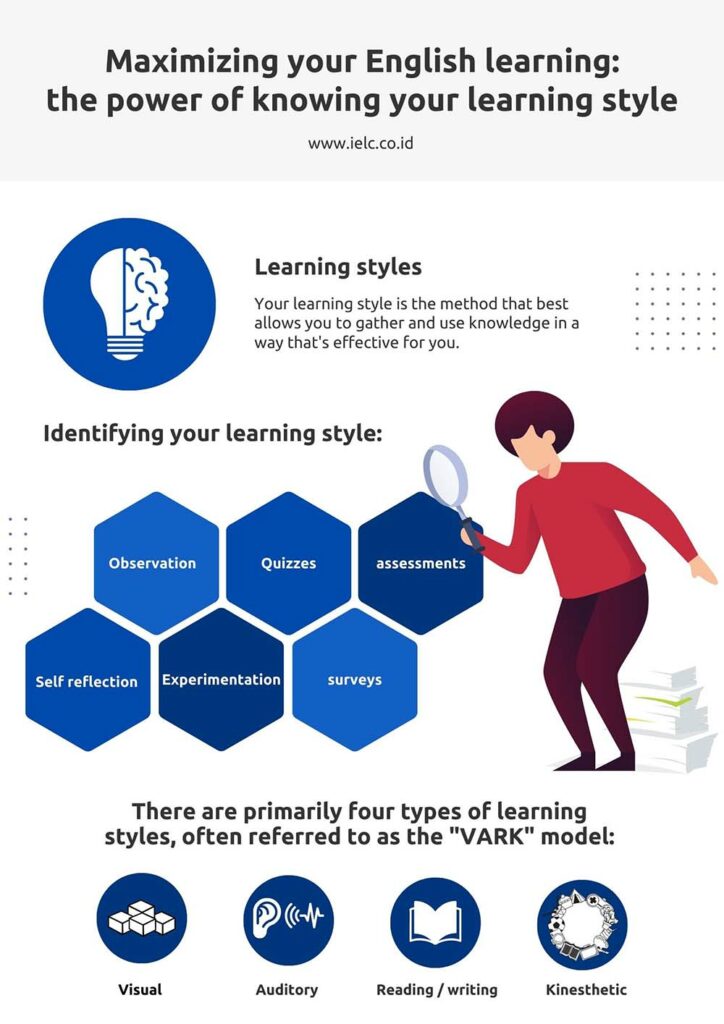
Maximizing your English learning: the power of knowing your learning style
Welcome, English learners!
On your English learning journey, have you ever wondered why some methods or techniques seem to work wonders for others, but when you try them, they just don’t quite hit the mark?
Well, the answer might lie not in the method itself, but in how it aligns with your unique learning style!
Yes, that’s right! We all have our preferred ways of learning, and understanding your learning style can be a game-changer in how effectively you acquire new knowledge and skills, especially when it comes to learning a foreign language.
In this blog post, we’re going on a deep-dive into different learning styles and exploring how you can adapt them to supercharge your English language journey.
Ready to find out? Let’s get started!

Learning style? What is that?
Learning styles were first introduced in the 1970s and have since become a cornerstone in understanding how we learn best. Essentially, your learning style is the method that best allows you to gather and use knowledge in a way that’s effective for you. There are primarily four types of learning styles, often referred to as the “VARK” model:
- Visual (learning through seeing)
- Auditory (learning through listening)
- Reading/Writing (learning through text)
- Kinesthetic (learning through doing and moving)
Now that we’ve unpacked the whole concept of learning styles, you might be scratching your head, wondering, “This is fantastic, but how do I pinpoint my own learning style?” Excellent question!
Identifying your learning style
Now that we’ve unpacked the whole concept of learning styles, you might be scratching your head, wondering, “This is fantastic, but how do I pinpoint my own learning style?” Excellent question!
Identifying your unique learning style is a thrilling adventure into self-discovery, and guess what? It’s simpler than you might think.
- Self reflection
Take some time to think about how you naturally take in information. When you learn something new, what methods work best for you? For example, if you find that you remember things better when you write them down or read them, you might be a reading/writing learner. If you learn best when you’re actively doing something, like building, drawing, or acting something out, you might be a kinesthetic learner.
- Observation
Notice how you prefer to spend your leisure time or what hobbies attract you. Are you drawn to activities that involve a lot of listening or speaking, such as listening to podcasts? You might be an auditory learner. If you enjoy visual arts, painting, photography, or graphic design, you might be a visual learner.
- Experimentation
Another way to identify your learning style is by experimenting with different learning methods. Try studying a new topic using each of the learning styles. For instance, if you’re trying to learn new English vocabulary, spend some time writing the words and their meanings (reading/writing), then draw a picture or symbol for each word (visual), next, listen to the pronunciation and repeat the words out loud (auditory), and finally, try to act out each word or use gestures to represent each word (kinesthetic). After trying all methods, reflect on which technique made the learning process more enjoyable and effective for you.
- Quizzes, surveys, or assessments
There are many online quizzes available that can help you identify your learning style. These quizzes generally ask about your preferences in various learning situations. While they should not be used as a definitive guide, they can provide some insights into your potential learning style. Some examples are the VARK questionnaire and the Index of Learning Styles.
Breaking down the learning styles
Now that we’ve traversed the terrain of self-discovery and potentially pinpointed your learning style, let’s delve deeper. Understanding is the first step, but to truly harness the power of your learning style, we need to explore each one in detail.
Are you a visual learner, an auditory learner, a reading/writing learner, or a kinesthetic learner? Each learning style comes with its unique characteristics, benefits, and strategies that can be employed for effective English language learning. And here’s the fascinating part: you might find that you connect with more than just one style!
Ready to uncover the distinctive features of each learning style and see how it can transform your English learning experience? Then let’s dive in, one learning style at a time!
- Visual learners
If you’re a visual learner, diagrams, charts, and mind maps are your best friends! You understand and remember things best when you see them visually. This can be a major advantage in your English learning journey. For instance, try using visual aids such as flashcards with pictures, infographics, or apps that provide visually engaging content. Watching English movies or videos can also be a great way to acquire new vocabulary and understand context. And don’t forget color-coding! Using different colors to highlight grammatical structures or new words can significantly boost your retention!
- Auditory learners
Are you the kind of person who prefers listening to podcasts over reading a book? Then you might be an auditory learner. You understand and remember things through hearing and listening. You might find that you remember things better when you say them out loud. As for English learning, exploit this strength by immersing yourself in English audio resources. Listening to English songs, podcasts, or audiobooks can be an excellent way to boost your listening skills and pronunciation. Also, try reading out loud or using voice recording apps to practice speaking and listen back for self-correction.
- Reading/writing learners
Reading/writing learners favor information displayed as words, and they have a high affinity for reading, writing, and text-based inputs. To maximize your English learning experience, you can dive into the world of English literature, from books and magazines to blogs and news articles. You can also start an English journal where you write about your day, ideas, or experiences.When learning new words, write them down along with their meanings, synonyms, and examples.
- Kinesthetic learners
Finally, if you are a kinesthetic learner, you learn best through physical activities rather than sitting and listening to a lecture. The idea of ‘learning by doing’ is what works for you. You can incorporate this into your English learning journey in numerous ways. Role-play or drama activities can be excellent for practicing speaking skills. Building or crafting projects related to English can also be helpful. For example, creating a scrapbook with vocabulary or phrases can marry your need for movement with language learning. Move around while studying, such as pacing while you’re memorizing or gesturing when you’re speaking.
Summary
Remember, it’s normal to identify with more than one learning style. What’s more, knowing your learning style is not about limiting yourself, but about leveraging your strengths in your English learning journey. So feel free to experiment with different methods and mix and match strategies until you find the perfect combination that works for you!
Next steps
Do you want to speak English with confidence?
Most people lack confidence when they speak English. They are afraid to make mistakes and are embarrassed to speak in front of others.
This is because they have been taught English the wrong way!
Most English courses waste your time and money on useless exercises that don’t bring results. Even worse, they teach you bad habits that are very difficult to unlearn.
As a result, you become confused and lack confidence. This is wrong!
At IELC, we teach English the right way
Our goal is to get you speaking in English with fluency and confidence as fast as possible. We want to give you the skills you need to fulfil your potential!
Our experienced teachers will guide you along every step of the learning process to ensure that you are not wasting your time, money, and energy on useless language exercises & wrong methods.
Our courses
With our modern campus and technology, we are equipped to provide the best possible courses for children, teens, and adults, including:
Online and on campus IELTS courses
Online and on campus TOEFL PBT courses
Online and on campus TOEFL iBT courses
We offer our classes in group classes or private classes.
No matter what your goals are, our team will help you achieve these goals by providing you with Indonesia’s best English courses!
Talk to our team today to get your FREE consultation and take your first step towards success.
Sincerely,

IELC Academic Director
